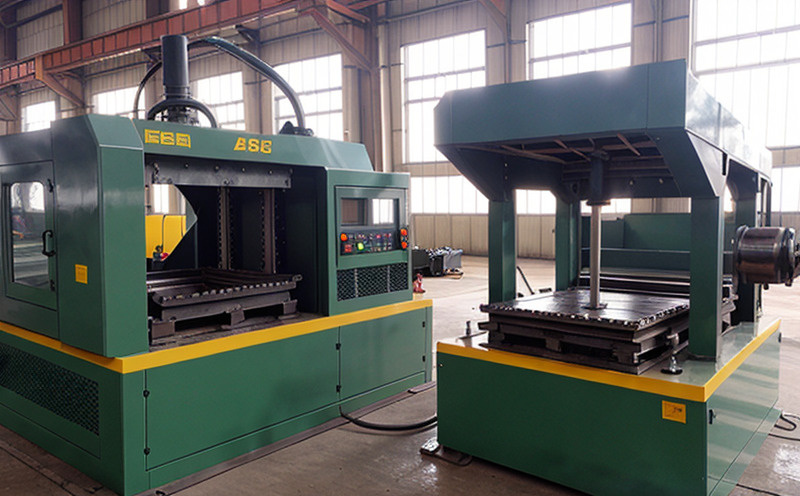ASTM E165 Penetrant Testing of Forged Components
The ASTM E165 standard specifies a penetrant testing method that is widely used for detecting surface-breaking defects in forged components. This non-destructive testing (NDT) technique involves applying a penetrating liquid to the surface of the component, allowing it to seep into any open surface cracks or discontinuities. After drying, a developer is applied to draw out the penetrant from these defects making them visible.
The process is critical in industrial manufacturing and processing as it ensures that forged components meet the required quality standards before being used in applications where safety and reliability are paramount. For instance, aerospace, automotive, and medical industries rely heavily on this testing method to detect flaws such as cracks, porosity, or incomplete fusion.
The ASTM E165 procedure can be tailored according to specific requirements, which may vary based on the material type and component geometry. Materials commonly tested include steel, stainless steel, aluminum, titanium alloys, and copper-based materials. The testing process is particularly useful for components that have been subjected to high heat treatments or severe forming processes.
For quality managers and compliance officers, ASTM E165 provides a standardized method to ensure consistent results across different batches of products. R&D engineers can use this test to optimize the forging parameters by identifying the optimal conditions under which defects are minimized. In procurement, this testing ensures that only high-quality raw materials are used in production.
During the ASTM E165 procedure, several steps must be followed meticulously. The first step involves cleaning the component's surface thoroughly to remove any oil, grease, or dirt that could interfere with the penetrant’s ability to penetrate defects. Next, a suitable penetrating liquid is applied and allowed to sit for a specified time based on the material type. After drying, a developer is applied which enhances defect contrast.
The testing process can be challenging due to the varying surface finishes and complex geometries of forged components. Specialized equipment may be required to ensure accurate testing, such as ultrasonic flaw detectors or visual inspection tools. The results are then interpreted by trained personnel who look for any indications that might suggest the presence of defects.
The ASTM E165 standard is recognized globally and is widely accepted in international manufacturing sectors due to its reliability and repeatability. This recognition ensures that testing results are comparable across different countries, which is crucial for global supply chains.
Why It Matters
The ASTM E165 penetrant testing method plays a vital role in ensuring the integrity and reliability of forged components. In industries such as aerospace and automotive, where safety is non-negotiable, any flaw can have catastrophic consequences. By identifying surface-breaking defects early in the manufacturing process, this test helps prevent costly reworks and recalls.
For forging companies, consistent compliance with ASTM E165 ensures that they meet the stringent quality standards required by end-users. This not only enhances their reputation but also opens up new market opportunities in competitive sectors.
The testing process is particularly important for materials like steel and titanium, which are prone to developing defects during forging due to high temperatures and pressures. By using ASTM E165, manufacturers can ensure that these materials meet the required specifications before they are used in critical applications such as aircraft parts or medical devices.
For quality assurance teams, this test provides a robust method for evaluating component quality. It allows them to identify potential issues early on and implement corrective actions to maintain product quality. This proactive approach not only improves customer satisfaction but also reduces the risk of product failures in the field.
International Acceptance and Recognition
- The ASTM E165 standard is widely recognized by international standards organizations such as ISO, IEC, and EN. This global acceptance ensures that testing results are consistent across different countries, making it an essential tool for manufacturers operating in a global market.
- Many countries have adopted ASTM E165 as part of their national standards for non-destructive testing methods. This adoption supports international trade by ensuring that forged components meet the same quality criteria regardless of where they are manufactured or used.
- The standard is also used in conjunction with other international standards like ISO 9712, which covers qualifications and certification for personnel performing non-destructive testing. This combination ensures a high level of expertise among those conducting ASTM E165 tests.
- International acceptance extends to regulatory bodies as well. For instance, the Federal Aviation Administration (FAA) in the United States and the European Union Aviation Safety Agency (EASA) recognize ASTM E165 for its role in ensuring airworthiness of aircraft components.
Environmental and Sustainability Contributions
The ASTM E165 penetrant testing method contributes positively to environmental sustainability by minimizing the need for reprocessing or discarding defective parts. By identifying defects early in the manufacturing process, this test helps ensure that only high-quality components are used, reducing waste and conserving resources.
In the context of industrial manufacturing, sustainable practices are becoming increasingly important as companies aim to reduce their carbon footprint. ASTM E165 supports these efforts by ensuring that forged components meet strict quality standards without compromising on environmental considerations. For example, in aerospace manufacturing, where fuel efficiency is crucial for reducing emissions, the use of defect-free components contributes significantly to overall sustainability.
The testing process itself has minimal environmental impact. The penetrant and developer solutions used are typically water-based or alcohol-soluble, which are less harmful than many other chemicals used in industrial processes. Furthermore, the test is non-destructive, meaning that it does not damage the component being tested, thus preserving valuable resources.
Manufacturers who adopt ASTM E165 as part of their quality control processes can demonstrate their commitment to sustainability by ensuring that only high-quality components are used in production. This not only reduces waste but also contributes to the overall efficiency and longevity of products, which is beneficial for both the environment and business operations.





